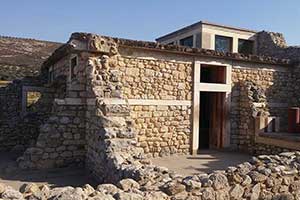Knossos
The Palace of Knossos
Knossos is situated only a few minutes’ drive from the Capital Heraklion. Knossos was discovered in 1878 by Minos Kalokairinos, a Cretan merchant and antiquarian. The English archaeologist Arthur Evans was able to purchase the entire site and conduct the main excavations in 1900.The Palace of Knossos is the largest of the preserved Minoan palatial centres. Dated to 2000-1350 B.C. Four wings are arranged around a central courtyard, containing the royal quarters, workshops, shrines, storerooms, repositories, the throne room and banquet halls.
The Little Palace lies to the west of the main palace and has all the features of palatial architecture: scraped wall masonry, reception rooms, a pristyle hall, a double megaron with polythyra Dated to the 17th-15th centuries B.C.The Royal Villa dated to the 14th century B.C its architectural form is distinguished by the polythyra, the pillar crypt and the double staircase, with two flights of stairs.
House of the Frescoes is a small urban mansion with rich decoration on the walls, dated to the 15th, 14th-12th centuries B.C.
The Caravanserai was interpreted as a reception hall and hospice. Some of the rooms are equipped with baths and decorated with wall paintings. The "Unexplored Mansion" is a private building, probably of private-industrial function. Dated to the 14th-12th centuries B.C.
The Temple Tomb to the south of the palace it related to the "House of the High Priest" by means of a paved street. It seems that one of the last kings of Knossos (17th-14th centuries B.C.) was buried here. House of the High Priest to the south of Caravanserai and contains a stone altar with two columns, framed by the bases of double axes. The South Mansion is a private civic house dating from the 17th-15th centuries B.C. is located to the south of the palace.
More information for booking the best Hotels, Apartments and Villas in East Crete: info@kreta.com, The Crete-Experts have the best ideas for Crete




































